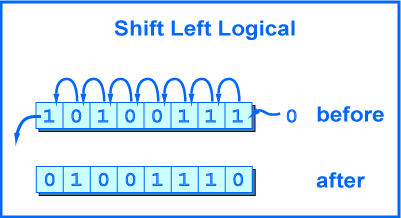Shift Left Logical

A shift left logical of one position moves each bit to the left by one. The low-order bit gets a zero (in all cases) and the high-order bit is discarded.
Bit patterns are usually written with a space every four bits. Of course, he space is not part of the pattern and does not take place in the shift.
Shifting by two positions is the same as performing a one-position shift two times. Shifting by zero positions leaves the pattern unchanged. Shifting an N-bit pattern left by N or more positions changes all of the bits to zero.
The picture shows the operation performed on eight bits.
The original pattern is
1010 01110100 1110
The MIPS processor always performs the operation on a 32-bit register and puts the result in a 32-bit register.
sll d,s,shft # $d <-- the bits in $s shifted left logical
# by shft positions,
# where 0 <= shft < 32
The ALU (arithmetic/logic unit) which does the operation pays no attention to what the bits mean. If the bits represent an unsigned integer, then a left shift is equivalent to multiplying the integer by two.